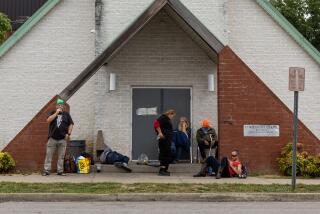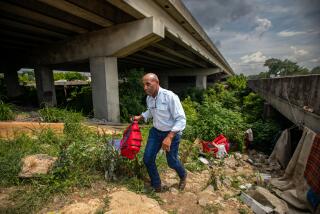Holding Out Hope for Housing in Jackson
Martin and Michelle Frank both grew up in the Jackson, Wyo., area, but they were almost forced out because they couldn’t afford to stay.
“I know of several people that we went to high school with that have had to move out of town,” said Michelle, a night desk clerk at a local motel.
With spectacular mountain views, good skiing and easy access to two of the country’s best-known national parks--Yellowstone and Grand Teton--Jackson has seen housing costs soar.
But the Franks, who have a 6-month-old daughter, were among the lucky ones. They found an affordable three-bedroom home in the northwest Wyoming community through the Jackson Hole Community Housing Trust.
With help from the Teton County Housing Authority, the trust has completed 51 housing units on land it bought with private donations.
Trust official Sara Carroll said the organization provides a 99-year lease to homeowners, which helps ensure that the value of trust-owned land increases much more slowly than other private land in the county.
The value of the trust-owned land increases by only 3% to 4% annually, compared with increases of 10% to 20% for other private land in Teton County, said Franz Camenzind, director of the Jackson Hole Conservation Alliance.
Real estate in Jackson is stretched thin because only about 3% of the land in Teton County is privately owned. Much of that either has been protected from development by conservation easements or has already been developed.
“There’s no question that we have a problem, because the land base is finite but our needs keep growing,” he said.
As the Jackson area becomes a more popular year-round tourism destination and attracts more people who build expensive second or third homes, the need increases for workers Carroll called the “underpinnings” of the town. They’re the teachers, hospital workers, police officers, carpenters--like Martin Frank--and laborers who make the town tick.
The U.S. Census Bureau reported Teton County’s 1994 median income--meaning half the county’s residents earned more and half earned less--was $37,420.
In 1995, according to the Jackson Hole Chamber of Commerce, the median price of a single-family home was $290,000, and the median price of a single-family condominium was $150,000. A 1997 estimate put the median sale price of a home in Teton County at about $400,000.
Rental units were correspondingly expensive, with a typical apartment renting for $682 per month and a typical rental house going for $1,077 per month in the second quarter of 1997. Rental costs for all of Wyoming during that period were $379 for an apartment and $513 for a house, according to the semi-private Wyoming Housing Data Base Partnership.
“In any other kind of community, the kinds of people who live here would be able to afford a home: a bank president, a restaurant manager, but because of the price of land in this community and the dearth of land . . . the problem is exponential,” Carroll said.
The problem worsens in late spring and late fall, when seasonal workers pour in to help handle the influx of summer and winter tourists.
Until a recent clampdown, as many as 1,000 summer seasonal workers who could not find affordable housing in Jackson lived illegally in the Bridger-Teton National Forest just outside town.
“It’s not necessarily that there’s not any housing; it’s just that they charge so much for it,” said Michelle Frank. “Most people have to work at least two jobs just to be able to afford a place.”
More to Read
Sign up for Essential California
The most important California stories and recommendations in your inbox every morning.
You may occasionally receive promotional content from the Los Angeles Times.










